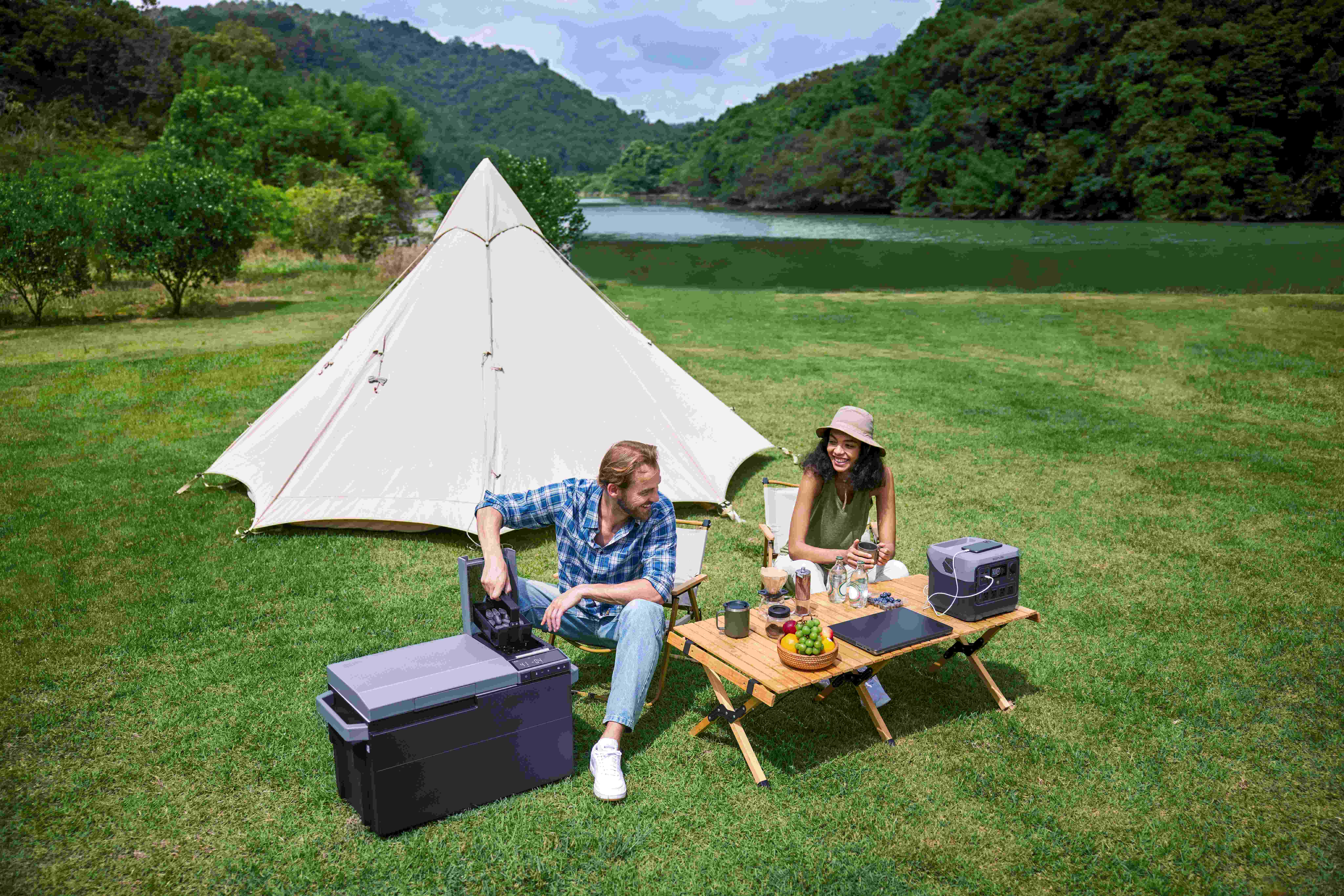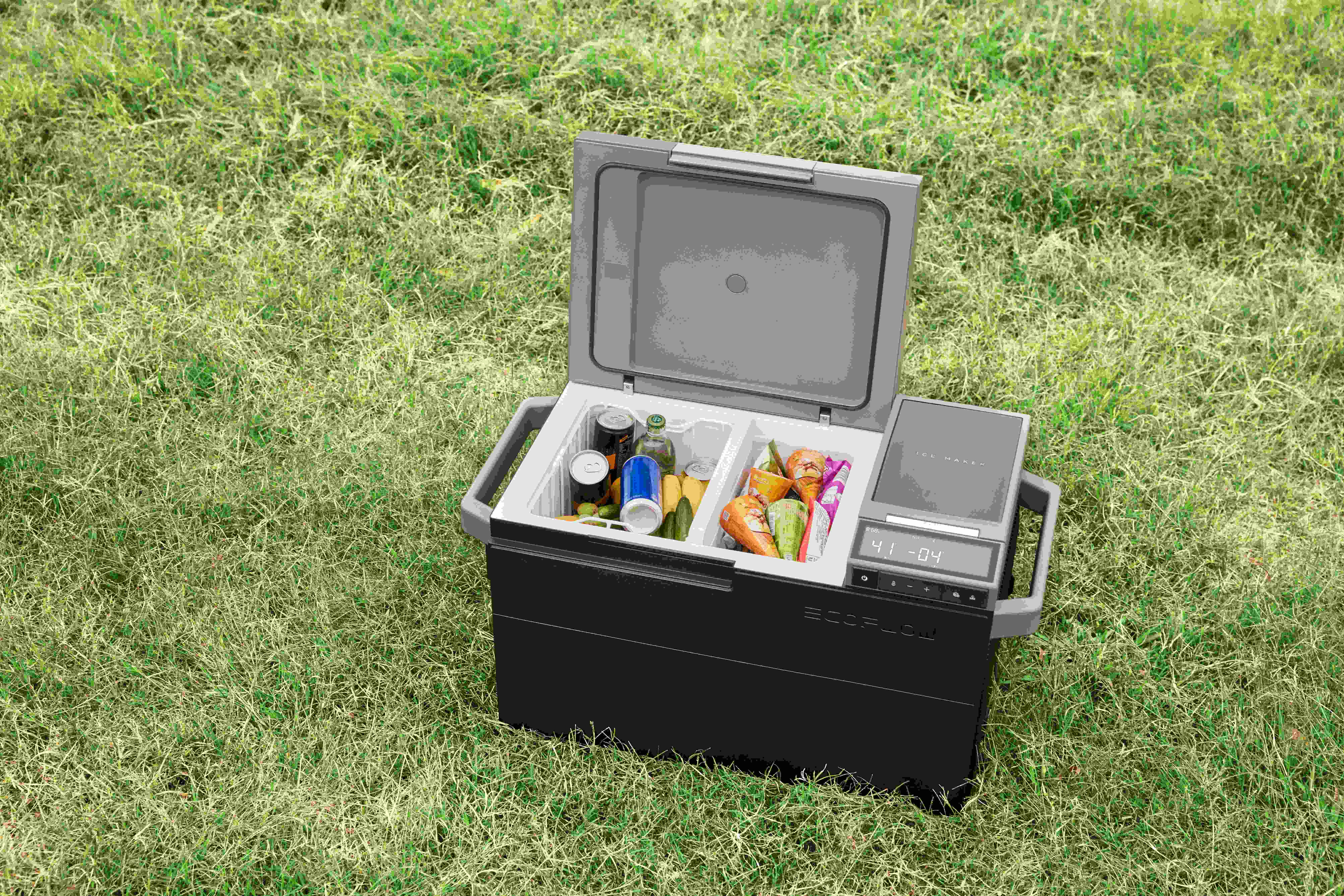What Type of Portable Refrigerator Is Best for Camper
- Portable Refrigerator Types: What Really Works on the Road
- What Campers Should Look For
- Performance in Real Outdoor Conditions
- How Much Power Do Campers Need?
- Smart Features That Make a Difference
- Meet EcoFlow GLACIER: Cold Storage Built for Campers
- Final Thoughts
- FAQ About Portable Refrigerators for Campers
Warm days and long drives mean your cooler needs to do more than just keep drinks chilly for a few hours. For campers, the right portable refrigerator turns food storage into something you can count on—even miles from the nearest power outlet. If you want fresh food, cold drinks, and the ability to freeze meat or make ice, a good fridge isn’t optional. It’s essential.
But not all portable fridges are the same. Some are better suited to short day trips. Others can handle full off-grid weekends or even support life in an RV. Below, we walk through the types, features, and performance points to help campers pick the right fit.
Portable Refrigerator Types: What Really Works on the Road
Campers will run into three main types of portable cooling devices. Each uses a different method to drop and hold temperature. Understanding the core differences helps avoid buying something that just acts like a cooler in disguise.
Compressor Fridge
- Uses refrigerant and a compressor
- Works like a household fridge
- Reliable cold and freeze settings (down to -13°F / -25°C)
- Holds temperature even in extreme outdoor heat
- Great for long trips or full-day use
Thermoelectric Cooler
- Uses electric current across plates to transfer heat
- Quiet and compact
- Limited cooling (usually only 30°F below ambient temperature)
- Best for mild weather and short drives
- Cannot freeze food
Absorption Cooler
- Uses ammonia or gas-based chemical cycle
- Works on AC, DC, or propane
- No moving parts, but cools slowly and unevenly
- Sensitive to tilt; not ideal for rough roads or uneven campsites
Most campers who need stable, food-safe cold storage—even overnight—will want a compressor-based model.


What Campers Should Look For
You’re not shopping for a dorm fridge. Your needs are mobile, variable, and often outdoors. These are the main factors campers should check before picking a fridge model:
Storage Capacity
Think about your group size and trip length. A solo hiker may only need 15–20L. A weekend couple might prefer 30–40L. Family road trips often need 50L or more. Size affects not only how much food fits but also power use and weight.
Portability
Weight matters when moving the unit from the car to a tent, dock, or trailhead. Anything over 40 lbs (18 kg) should have handles or wheels. Detachable wheels help with trunk space and setup in tighter RVs or trucks.
Temperature Control
Manual dials aren’t enough anymore. Digital settings let you set exact degrees for fridge or freezer zones. Dual-zone models allow separate areas for fresh produce and frozen items in one unit.
Power Options
Campers may only have access to car batteries, solar panels, or a portable power station. A good unit should support DC input (12/24V), solar charging, and AC at home. Some models offer built-in or attachable batteries for cable-free cooling.
Performance in Real Outdoor Conditions
Campgrounds are rarely temperature-controlled. Shade shifts. Outside temperatures climb. Nights get cold. A good portable fridge must handle all these changes without risking food safety.
Here’s what separates the dependable ones:
- Cooling speed: High-watt compressors should bring the temperature from room temp to freezing in 15–30 minutes
- Stability: A good seal and compressor hold cold even during short power loss or shade shifts
- Angle tolerance: Units that operate while tilted (up to 30° or more) are better for uneven terrain or vanlife
- Weatherproof rating: Look for IPX4 or better to handle light rain or splash
Cheaper units may struggle during hot days or drop too far overnight, leading to spoiled items or frostbite.
How Much Power Do Campers Need?
A common question is: how long will this fridge run off-grid?
Let’s break it down.
- A typical compressor fridge consumes between 0.8–1.2 kWh per day in fridge mode
- That’s about 30–50W on average
- In freezing mode, expect closer to 1.5 kWh per day
To run for 24–40 hours without plugging in, you need a battery capacity around 250–300Wh or more. Solar charging helps extend run time, especially in sunny conditions.
Fridges with “Eco” or energy-saving modes can stretch time even further.
Smart Features That Make a Difference
A portable fridge doesn’t have to be basic. These extra features are worth looking out for, especially if you’re using the fridge often:
- App control: Set or check the temperature remotely via Bluetooth or Wi-Fi
- USB-C port: Charge your phone or camera on the same device
- Quick freeze button: Drop to freezing fast for ice or raw meat
- Dual zone switch: Convert part of the fridge into freezer space on demand
- Interior light: Useful for late-night camps or RV kitchens
For campers, every small detail helps. Features that save power, reduce trips to the store, or offer more flexibility often matter more than price alone.
Meet EcoFlow GLACIER: Cold Storage Built for Campers
The EcoFlow GLACIER stands out for campers looking for flexibility, strong cooling, and long off-grid performance.
- Compressor cooling: Drops from 86°F to 32°F in 15 minutes
- Dual zone system: Fridge and freezer in one, with independent controls
- 40-hour cable-free runtime: Use the optional plug-in battery (298Wh capacity)
- Solar-ready: Accepts up to 240W of direct solar input
- Built-in ice maker: Creates 18 cubes in just 12 minutes
- IPX4 splash-resistant: Handles unpredictable outdoor conditions
- Smart control: Set temps or switch zones via the EcoFlow App (Bluetooth/Wi-Fi)
- 100W USB-C port: Charge a phone or laptop on the go
With a 38L capacity and optional detachable wheels and handle, it’s built for mobile storage. You can keep it in your truck, wheel it to a picnic site, or dock it inside your camper van without hassle.


Final Thoughts
Campers need cooling gear that does more than hold in ice. A good portable refrigerator should handle long drives, bumpy terrain, sun-soaked afternoons, and full weekends off-grid. The right features—stable cooling, real freezer settings, multiple power options—turn a fridge into a real asset, not a liability.
EcoFlow GLACIER checks every major box for modern campers. Reliable cold. Smart controls. Flexible charging. If your adventures demand more from your gear, this fridge is ready to go wherever you do.
FAQ About Portable Refrigerators for Campers
Q1: How cold can a portable refrigerator get?
Most compressor models reach temperatures as low as -13°F (–25°C), cold enough to freeze meat and ice cream. Thermoelectric coolers usually stop at around 35–40°F below the surrounding air, which means they may not work well on hot days.
Q2: Do I need a dual-zone portable fridge for camping?
Not always. But if you want to store both frozen meat and fresh veggies on the same trip, it helps. Dual-zone models let you set different temperatures in two separate compartments, giving you more flexibility with food and drink.
Q3: How long will a portable fridge run on battery?
Run time depends on battery size, fridge settings, and the outside temperature. A 298Wh plug-in battery can keep a well-insulated compressor fridge running up to 40 hours in Eco mode, especially if you avoid opening the lid too often.
Q4: Can I use a portable fridge in bad weather?
Most well-made units handle dust, light rain, and road vibration. Look for models with at least an IPX4 waterproof rating and tilt tolerance for uneven campsites. Never leave the fridge submerged or exposed during storms.
Q5: What size portable refrigerator is best for a camper?
That depends on your storage needs. For solo or two-person trips, 25–38L is often enough. Larger families or those staying off-grid longer may need 45L or more. Always check dimensions to be sure it fits your vehicle setup.
Q6: Can I plug my fridge into a solar panel directly?
Yes, if the fridge supports solar input. Some models take 12V/24V DC power from a portable solar panel. For example, the EcoFlow GLACIER accepts up to 240W solar input with its plug-in battery attached, great for full off-grid use.
Q7: Is it safe to run a portable fridge overnight in a tent or vehicle?
Yes—compressor fridges are safe to use overnight, as long as they have proper ventilation and are set on a stable surface. Just be aware of slight fan noise (usually 40–45 dB) if you’re a light sleeper.